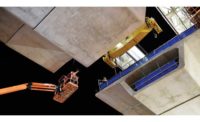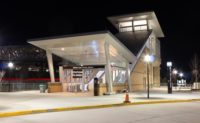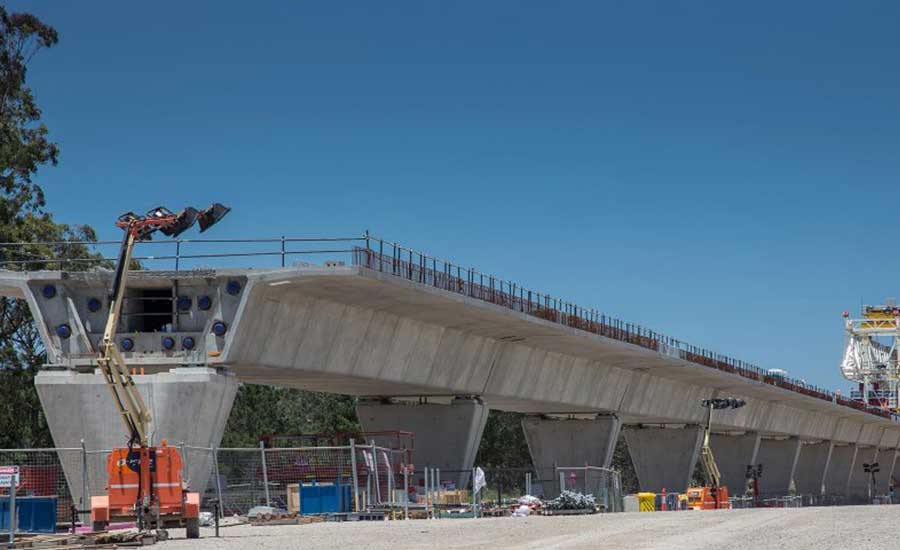Construction Methods
Structural Failure of Precast-Concrete Span Sets Back Sydney Metro Job
Detailed forensic analysis criticizes techniques used in segment grouting

Sydney’s Metro North West line is the largest mass-transit project in Australia.

One of 115 precast spans failed during construction last fall and has to be replaced.

An independent report cited insufficient clamping and concrete, and use of epoxy resin.



A key component of Australia’s biggest public transport infrastructure project—Sydney’s $6.3-billion Metro North West—is the subject of a critical and detailed technical report describing how an elevated viaduct span failed at a stitch joint between two precast segments during construction last September. Project officials say the affected span, which did not suffer a progressive collapse, has since been removed and its replacement fast-tracked to avoid further delays. Little additional detail was provided.
The so-called Skytrain section is one of 115 spans being constructed using the precast segmental span-by-span method, erecting a series of precast box-girder segments supported by an overhead gantry and then stressed longitudinally.
Sydney Metro Northwest, formerly called the North West Rail Link, is the first stage of Sydney Metro and will be the first fully automated metro rail system in Australia. Sydney Metro City & Southwest is the second stage. Sydney Metro Northwest is delivering eight new railway stations and 4,000 commuter parking spaces to Sydney’s growing North West region. Trains will run every four minutes at peak.
Italy’s Salini Impregilo won the $260-million contract to design and build the 6.2-kilometer project, which includes the 4.6-km viaduct and a 270-m-long cable-stayed railway bridge over a major arterial road. Construction began in December 2013. The contract grew to $298 million to accommodate the extra work required to clean up larger-than-expected quantities of contaminated land in locations along the alignment, including buried asbestos and dumped construction materials.
Last November, engineering consultant Aurecon Australasia released the results of its independent investigation for its client, Transport for NSW (TfNSW). It highlighted a combination of errors that led to the failure of Span 60. As a result, new controls have been introduced to improve the process, according to TfNSW.
The failure occurred in a stitch joint used to join two segments at the midpoint of Span 60. The use of a closure concrete pour at this location was a departure from the usual practice for match-cast segmental construction, in which each segment is cast against its neighbor to achieve a matching interface.
In the case of Span 60, this procedure was not possible for the joint between segments Nos. 5 and 6, since the original No. 5 segment was used for another part of the project. A new No. 5 segment had to be cast, with a cast-in-place closure pour between it and segment No. 6.
The report says a compression failure of the bottom flange of the box girder occurred in the closure pour between the two segments, some 33 hours after final stressing of the tendons. The failure caused a hinge point to form in the middle of the span, lifting up the girder about 700 millimeters from its original position. Then, the northern end of the box girder slid forward on the bearings on Pier 60, and the top flange of the southern end of the box girder clashed with the box girder of Span 59.
Aurecon says the damage was caused by insufficient temporary clamping pressure during the stitch-join construction process. As the structure cooled overnight, the segments pulled apart and the stitch joint cracked. The use of concrete of insufficient strength in the stitch joint and the use of an epoxy resin in an attempt to fix cracking in the joint exacerbated the problem.
TfNSW says that, following the report's recommendations, a number of changes will be made to the construction processes. These new procedures include increased clamping and longer concrete curing times for stitch joins to ensure the strength is more than sufficient. Further, the use of epoxy in stitch joins between concrete segments will be excluded. The client added that Span 60 was “soon” to be replaced.
Stavro Sofios, a spokesman for TfNSW, says the cost of rectifying the damage caused is a matter for the contractor. He added, “This unique, three-contract structure means the final Skytrain contract price may vary due to ongoing fine-tuning involving the two other major contracts. Any changes would be covered in the total $8.3 billion budgeted cost of the project."
A spokesperson for the contractor referred all questions to the client. Rodd Staples, project director for Sydney Metro North West, told the Sydney Morning Herald the event was “very disappointing.”
The report concurred, noting that a hazard identification workshop said "a timber ply bulkhead [should] be provided close against the northern end face of the Span 60 girder, covering all the anchorages and restrained in place." Other recommendations included concrete cylinder test cores during curing for both concrete and grouting.
Aurecon’s full report may be found at http://www.sydneymetro.info/sites/default/files/document-library/Report%20161221.pdf.








